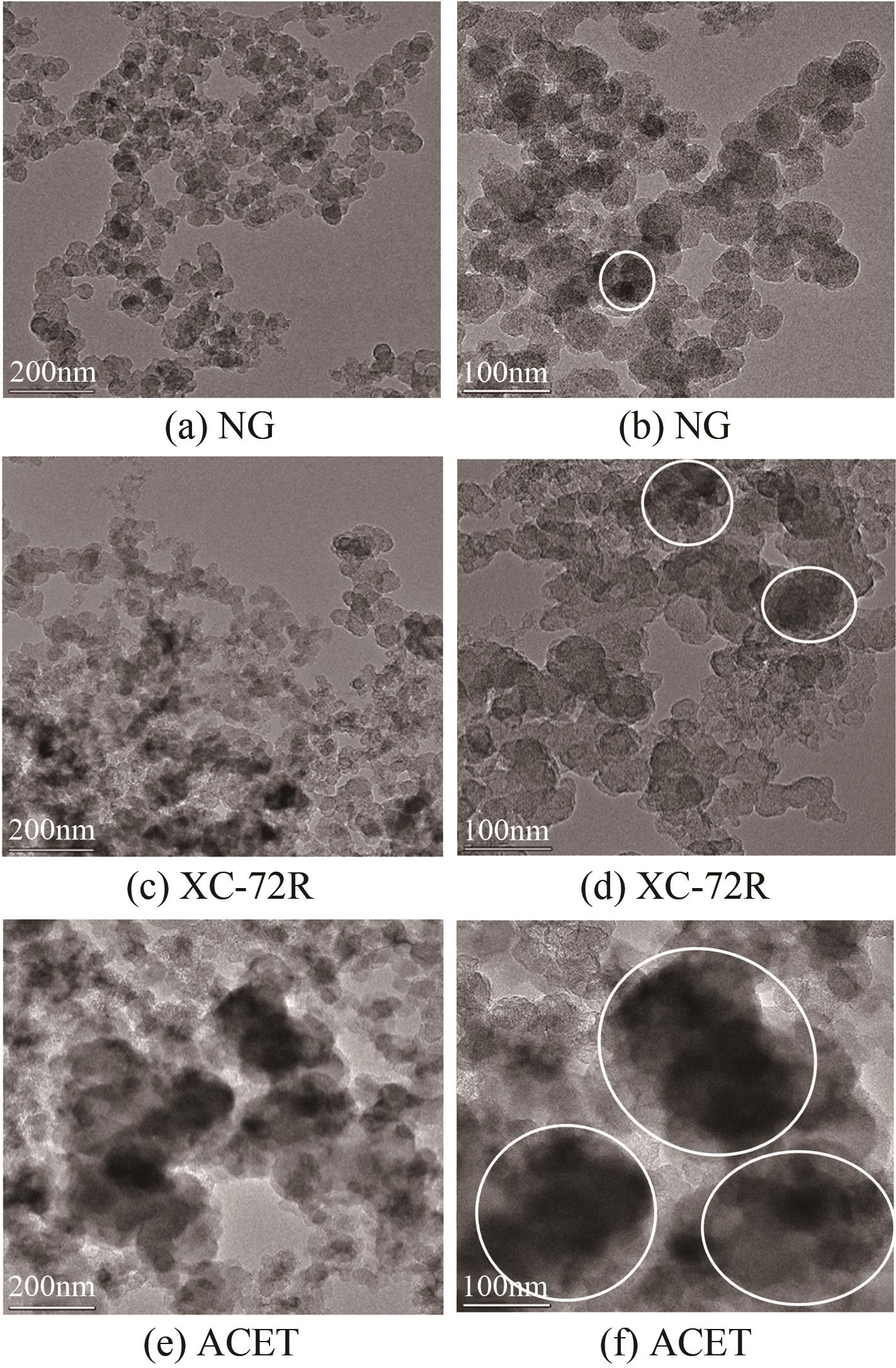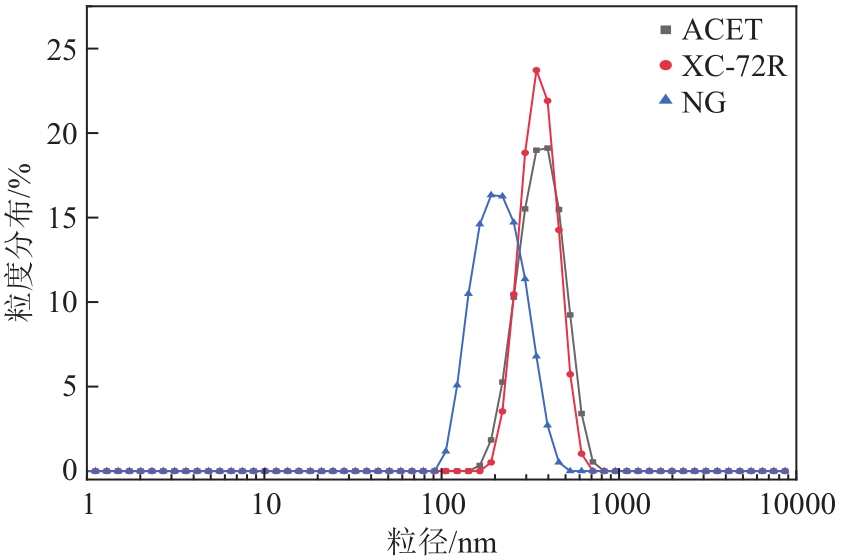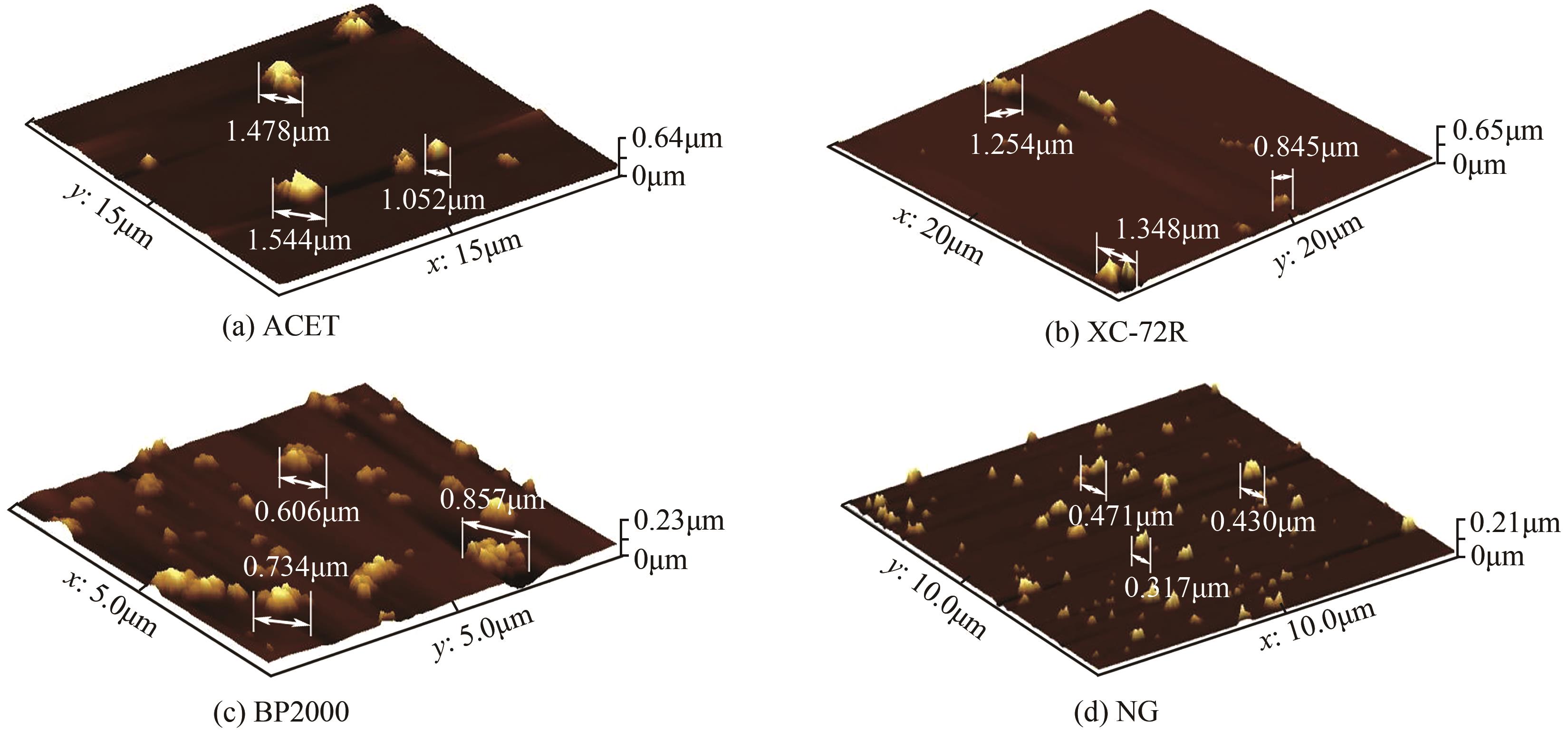Chemical Industry and Engineering Progress ›› 2022, Vol. 41 ›› Issue (7): 3808-3815.DOI: 10.16085/j.issn.1000-6613.2021-1856
• Materials science and technology • Previous Articles Next Articles
Microstructure and rheology of microporous layer ink for proton exchange membrane fuel cells
CHEN Zhekun( ), PAN Weitong, YAO Dingsong, DING Lu, WANG Fuchen(
), PAN Weitong, YAO Dingsong, DING Lu, WANG Fuchen( )
)
- Institute of Clean Coal Technology, East China University of Science and Technology, Shanghai 200237, China
-
Received:2021-08-03Revised:2021-09-29Online:2022-07-23Published:2022-07-25 -
Contact:WANG Fuchen
质子交换膜燃料电池微孔层浆液微观结构与流变性
- 华东理工大学洁净煤技术研究所,上海 200237
-
通讯作者:王辅臣 -
作者简介:陈哲坤(1996—),男,硕士研究生,研究方向为质子交换膜燃料电池。E-mail:1213592206@qq.com 。
CLC Number:
Cite this article
CHEN Zhekun, PAN Weitong, YAO Dingsong, DING Lu, WANG Fuchen. Microstructure and rheology of microporous layer ink for proton exchange membrane fuel cells[J]. Chemical Industry and Engineering Progress, 2022, 41(7): 3808-3815.
陈哲坤, 潘伟童, 姚顶松, 丁路, 王辅臣. 质子交换膜燃料电池微孔层浆液微观结构与流变性[J]. 化工进展, 2022, 41(7): 3808-3815.
share this article
Add to citation manager EndNote|Ris|BibTeX
URL: https://hgjz.cip.com.cn/EN/10.16085/j.issn.1000-6613.2021-1856
| 炭黑类型 | V总孔/m3·g-1 | V介孔+大孔/ m3·g-1 | V微孔/m3·g-1 |
|---|---|---|---|
| ACET | 0.168 | 0.167 | 0.001 |
| XC-72R | 0.441 | 0.410 | 0.031 |
| NG | 0.951 | 0.941 | 0.010 |
| 炭黑类型 | V总孔/m3·g-1 | V介孔+大孔/ m3·g-1 | V微孔/m3·g-1 |
|---|---|---|---|
| ACET | 0.168 | 0.167 | 0.001 |
| XC-72R | 0.441 | 0.410 | 0.031 |
| NG | 0.951 | 0.941 | 0.010 |
| 炭黑类型 | 平均粒径/nm | 多分散性指数 |
|---|---|---|
| ACET | 443.6 | 0.403 |
| XC-72R | 374.3 | 0.062 |
| NG | 209.5 | 0.040 |
| 炭黑类型 | 平均粒径/nm | 多分散性指数 |
|---|---|---|
| ACET | 443.6 | 0.403 |
| XC-72R | 374.3 | 0.062 |
| NG | 209.5 | 0.040 |
| 炭黑类型 | α/% | k | n | R2 |
|---|---|---|---|---|
| ACET | 3 | 1.807 | 0.213 | 0.993 |
| 4 | 2.781 | 0.188 | 0.996 | |
| 5 | 10.478 | 0.076 | 0.999 | |
| 6 | 55.951 | 0.039 | 0.998 | |
| 7 | 79.806 | 0.015 | 1.000 | |
| XC-72R | 3 | 1.149 | 0.340 | 0.963 |
| 4 | 1.359 | 0.310 | 0.974 | |
| 5 | 1.843 | 0.276 | 0.983 | |
| 6 | 8.023 | 0.118 | 0.992 | |
| 7 | 14.300 | 0.067 | 0.996 | |
| BP2000 | 3 | 0.732 | 0.396 | 0.937 |
| 4 | 0.961 | 0.389 | 0.962 | |
| 5 | 1.059 | 0.355 | 0.978 | |
| 6 | 1.218 | 0.320 | 0.978 | |
| 7 | 1.521 | 0.295 | 0.973 | |
| NG | 3 | 0.052 | 1.000 | — |
| 4 | 0.057 | 1.000 | — | |
| 5 | 0.070 | 1.000 | — | |
| 6 | 0.125 | 0.554 | 0.981 | |
| 7 | 0.674 | 0.233 | 0.981 |
| 炭黑类型 | α/% | k | n | R2 |
|---|---|---|---|---|
| ACET | 3 | 1.807 | 0.213 | 0.993 |
| 4 | 2.781 | 0.188 | 0.996 | |
| 5 | 10.478 | 0.076 | 0.999 | |
| 6 | 55.951 | 0.039 | 0.998 | |
| 7 | 79.806 | 0.015 | 1.000 | |
| XC-72R | 3 | 1.149 | 0.340 | 0.963 |
| 4 | 1.359 | 0.310 | 0.974 | |
| 5 | 1.843 | 0.276 | 0.983 | |
| 6 | 8.023 | 0.118 | 0.992 | |
| 7 | 14.300 | 0.067 | 0.996 | |
| BP2000 | 3 | 0.732 | 0.396 | 0.937 |
| 4 | 0.961 | 0.389 | 0.962 | |
| 5 | 1.059 | 0.355 | 0.978 | |
| 6 | 1.218 | 0.320 | 0.978 | |
| 7 | 1.521 | 0.295 | 0.973 | |
| NG | 3 | 0.052 | 1.000 | — |
| 4 | 0.057 | 1.000 | — | |
| 5 | 0.070 | 1.000 | — | |
| 6 | 0.125 | 0.554 | 0.981 | |
| 7 | 0.674 | 0.233 | 0.981 |
| 1 | 符冠云, 赵吉诗, 龚娟, 等. 2019年国内外氢能发展形势回顾及展望[J]. 中国能源, 2020, 42(3): 30-33. |
| FU Guanyun, ZHAO Jishi, GONG Juan, et al. Review of the development of hydrogen energy at home and abroad in 2019 and outlook for 2020[J]. Energy of China, 2020, 42(3): 30-33. | |
| 2 | OZDEN A, SHAHGALDI S, LI X G, et al. A review of gas diffusion layers for proton exchange membrane fuel cells—With a focus on characteristics, characterization techniques, materials and designs[J]. Progress in Energy and Combustion Science, 2019, 74: 50-102. |
| 3 | 焦魁, 王博文, 杜青. 质子交换膜燃料电池水热管理[M]. 北京: 科学出版社, 2020. |
| JIAO Kui, WANG Bowen, DU Qing. Proton exchange membrane fuel cell hydrothermal management[M]. Beijing: Science Press, 2020. | |
| 4 | PAN W T, WANG P H, CHEN X L, et al. Combined effects of flow channel configuration and operating conditions on PEM fuel cell performance[J]. Energy Conversion and management, 2020, 220: 113046. |
| 5 | PARK S, LEE J W, POPOV B N. A review of gas diffusion layer in PEM fuel cells: materials and designs[J]. International Journal of Hydrogen Energy, 2012, 37(7): 5850-5865. |
| 6 | 毛林昌, 金俊宏, 杨胜林, 等. 多孔纳米碳纤维作为质子交换膜燃料电池微孔层的性能[J]. 化工进展, 2020, 39(10): 3995-4001. |
| MAO Linchang, JIN Junhong, YANG Shenglin, et al. Performance of porous carbon nanofibers as microporous layer for proton exchange membrane fuel cells[J]. Chemical Industry and Engineering Progress, 2020, 39(10): 3995-4001. | |
| 7 | 罗马吉, 张鑫, 罗志平, 等. 微孔层对质子交换膜燃料电池水传输的影响[J]. 华中科技大学学报(自然科学版), 2010, 38(7): 36-39. |
| LUO Maji, ZHANG Xin, LUO Zhiping, et al. Effects of micro-porous layer on the water transport of PEMFC[J]. Journal of Huazhong University of Science and Technology (Natural Science Edition), 2010, 38(7): 36-39. | |
| 8 | YANG Y G, ZHOU X Y, LI B, et al. Recent progress of the gas diffusion layer in proton exchange membrane fuel cells: material and structure designs of microporous layer[J]. International Journal of Hydrogen Energy, 2021, 46(5): 4259-4282. |
| 9 | SADEGHIFAR H, DJILALI N, BAHRAMI M. Effect of polytetrafluoroethylene (PTFE) and micro porous layer (MPL) on thermal conductivity of fuel cell gas diffusion layers: modeling and experiments[J]. Journal of Power Sources, 2014, 248: 632-641. |
| 10 | KIM T, LEE S, PARK H. A study of water transport as a function of the micro-porous layer arrangement in PEMFCs[J]. International Journal of Hydrogen Energy, 2010, 35(16): 8631-8643. |
| 11 | WEBER A Z, NEWMAN J. Effects of microporous layers in polymer electrolyte fuel cells[J]. Journal of the Electrochemical Society, 2005, 152(4): A677. |
| 12 | ANTONACCI P, CHEVALIER S, LEE J, et al. Feasibility of combining electrochemical impedance spectroscopy and synchrotron X-ray radiography for determining the influence of liquid water on polymer electrolyte membrane fuel cell performance[J]. International Journal of Hydrogen Energy, 2015, 40(46): 16494-16502. |
| 13 | BLANCO M, WILKINSON D P. Investigation of the effect of microporous layers on water management in a proton exchange membrane fuel cell using novel diagnostic methods[J]. International Journal of Hydrogen Energy, 2014, 39(29): 16390-16404. |
| 14 | LI B, XIE M, JI H, et al. Optimization of cathode microporous layer materials for proton exchange membrane fuel cell[J]. International Journal of Hydrogen Energy, 2021, 46(27): 14674-14686. |
| 15 | 李超明, 康敬欣, 刘勇. 质子交换膜燃料电池微孔层研究进展[J]. 化工新型材料, 2020, 48(9): 256-259. |
| LI Chaoming, KANG Jingxin, LIU Yong. Research progress on MPL of proton exchange membrane fuel cell[J]. New Chemical Materials, 2020, 48(9): 256-259. | |
| 16 | YAN W M, WU D K, WANG X D, et al. Optimal microporous layer for proton exchange membrane fuel cell[J]. Journal of Power Sources, 2010, 195(17): 5731-5734. |
| 17 | FAN C C, CHANG M H. Improving proton exchange membrane fuel cell performance with carbon nanotubes as the material of cathode microporous layer[J]. International Journal of Energy Research, 2016, 40(2): 181-188. |
| 18 | XU F, ZHANG H Y, HO D, et al. Investigation of catalyst ink dispersion using small angle X-ray and small angle neutron scattering[J]. ECS Transactions, 2019, 33(1): 1335-1345. |
| 19 | GALLO STAMPINO P, CRISTIANI C, DOTELLI G, et al. Effect of different substrates, inks composition and rheology on coating deposition of microporous layer (MPL) for PEM-FCs[J]. Catalysis Today, 2009, 147: S30-S35. |
| 20 | LATORRATA S, STAMPINO P G, AMICI E, et al. Effect of rheology controller agent addition to micro-porous layers on PEMFC performances[J]. Solid State Ionics, 2012, 216: 73-77. |
| 21 | TAKAHASHI S, MASHIO T, HORIBE N, et al. Analysis of the microstructure formation process and its influence on the performance of polymer electrolyte fuel-cell catalyst layers[J]. ChemElectroChem, 2015, 2(10): 1560-1567. |
| 22 | PAN W T, CHEN Z K, YAO D S, et al. Microstructure and macroscopic rheology of microporous layer nanoinks for PEM fuel cells[J]. Chemical Engineering Science, 2021, 246: 117001. |
| 23 | LONG C M, NASCARELLA M A, VALBERG P A. Carbon black vs. black carbon and other airborne materials containing elemental carbon: physical and chemical distinctions[J]. Environmental Pollution, 2013, 181: 271-286. |
| 24 | KHANDAVALLI S, PARK J H, KARIUKI N N, et al. Rheological investigation on the microstructure of fuel cell catalyst inks[J]. ACS Applied Materials & Interfaces, 2018, 10(50): 43610-43622. |
| 25 | 张宇. 纳米颗粒增强气液传质的实验和模型研究[D]. 北京: 清华大学, 2016. |
| ZHANG Yu. Experimental and model study of gas-liquid mass transfer enhancement by nanoparticles[D]. Beijing: Tsinghua University, 2016. | |
| 26 | 张胜寒, 韩晓雪. 纳米颗粒表面修饰对纳米流体黏度的影响[J]. 科学技术与工程, 2018, 18(21): 168-174. |
| ZHANG Shenghan, HAN Xiaoxue. Effect of different surface properties of nanoparticles on the viscosity of nanofluids[J]. Science Technology and Engineering, 2018, 18(21): 168-174. | |
| 27 | 吴瑞娟. 中性墨水稳定性影响因素研究[D]. 太原: 太原理工大学, 2014. |
| WU Ruijuan. The study on the factors of stability of gel ink[D]. Taiyuan: Taiyuan University of Technology, 2014. | |
| 28 | AOKI Y, HATANO A, WATANABE H. Rheology of carbon black suspensions. I. Three types of viscoelastic behavior[J]. Rheologica Acta, 2003, 42(3): 209-216. |
| 29 | SOBOLEVA T, ZHAO X, MALEK K, et al. On the micro-, meso-, and macroporous structures of polymer electrolyte membrane fuel cell catalyst layers[J]. ACS Applied Materials & Interfaces, 2010, 2(2): 375-384. |
| 30 | SOCHI T. Non-Newtonian flow in porous media[J]. Polymer, 2010, 51(22): 5007-5023. |
| 31 | NEGI A S, OSUJI C O. New insights on fumed colloidal rheology—shear thickening and vorticity-aligned structures in flocculating dispersions[J]. Rheologica Acta, 2009, 48(8): 871-881. |
| 32 | AOKI Y, CO A, LEAL G L, et al. Rheology of carbon black suspensions: effect of carbon black structure[C]//AIP Conference Proceedings. Monterey, 2008. |
| 33 | 郭宇蓉. 锂电池浆料搅拌与涂布工艺的仿真及实验研究[D]. 太原: 太原科技大学, 2019. |
| GUO Yurong. Simulation and experimental study on stirring and coating process of lithium battery slurry[D]. Taiyuan: Taiyuan University of Science and Technology, 2019. | |
| 34 | KUMANO N, KUDO K, AKIMOTO Y, et al. Influence of ionomer adsorption on agglomerate structures in high-solid catalyst inks[J]. Carbon, 2020, 169: 429-439. |
| [1] | CHEN Kuangyin, LI Ruilan, TONG Yang, SHEN Jianhua. Structure design of gas diffusion layer in proton exchange membrane fuel cell [J]. Chemical Industry and Engineering Progress, 2023, 42(S1): 246-259. |
| [2] | XU Jiaheng, LI Yongsheng, LUO Chunhuan, SU Qingquan. Optimization of methanol steam reforming process [J]. Chemical Industry and Engineering Progress, 2023, 42(S1): 41-46. |
| [3] | ZHANG Qi, ZHAO Hong, RONG Junfeng. Research progress of anti-toxicity electrocatalysts for oxygen reduction reaction in PEMFC [J]. Chemical Industry and Engineering Progress, 2023, 42(9): 4677-4691. |
| [4] | ZHANG Yaojie, ZHANG Chuanxiang, SUN Yue, ZENG Huihui, JIA Jianbo, JIANG Zhendong. Application of coal-based graphene quantum dots in supercapacitors [J]. Chemical Industry and Engineering Progress, 2023, 42(8): 4340-4350. |
| [5] | ZHAO Jian, ZHUO Zewen, DONG Hang, GAO Wenjian. A new method for observation of microstructure of waxy crude oil and its emulsion system [J]. Chemical Industry and Engineering Progress, 2023, 42(8): 4372-4384. |
| [6] | JIANG Bolong, CUI Yanyan, SHI Shunjie, CHANG Jiacheng, JIANG Nan, TAN Weiqiang. Synthesis of transition metal Co3O4/ZnO-ZIF oxygen reduction catalyst by Co/Zn-ZIF template method and its electricity generation performance [J]. Chemical Industry and Engineering Progress, 2023, 42(6): 3066-3076. |
| [7] | MA Zhejie, ZHANG Wenli, ZHAO Xuankai, LI Ping. Progress on the influence of oxygen mass transfer resistance in PEMFC cathode catalyst layer [J]. Chemical Industry and Engineering Progress, 2023, 42(6): 2860-2873. |
| [8] | XU Xian, CUI Louwei, LIU Jie, SHI Junhe, ZHU Yonghong, LIU Jiaojiao, LIU Tao, ZHENG Hua’an, LI Dong. Effect of raw material composition on the development of semicoke mesophase structure [J]. Chemical Industry and Engineering Progress, 2023, 42(5): 2343-2352. |
| [9] | YU Haiqiang, GUO Quanzhong, DU Keqin, WANG Chuan. Application of pulse electrodeposition PbO2 coating on stainless steel bipolar plate of PEMFC [J]. Chemical Industry and Engineering Progress, 2023, 42(2): 917-924. |
| [10] | GAO Weitao, YIN Qinan, TU Ziqiang, GONG Fan, LI Yang, XU Hong, WANG Cheng, MAO Zongqiang. Proton transport in metal-organic frameworks and their applications in proton exchange membranes [J]. Chemical Industry and Engineering Progress, 2022, 41(S1): 260-268. |
| [11] | SUN Nana, SUN Huina, SHEN Lisha, SU Ruiyu, ZHAO Chao. Synergistic demulsification of magnetic nanoparticle-microwave on heavy oil O/W emulsion [J]. Chemical Industry and Engineering Progress, 2022, 41(6): 3127-3137. |
| [12] | PAN Wenzheng, JI Zhiyong, WANG Jing, LI Shuming, HUANG Zhihui, GUO Xiaofu, LIU Jie, ZHAO Yingying, YUAN Junsheng. Research on the electricity production performance and degradation process of microbial fuel cell treating azo-dye saline wastewater [J]. Chemical Industry and Engineering Progress, 2022, 41(6): 3306-3313. |
| [13] | GONG Xin, LIU Xiaodong, WEN Fushan, SHI Nan, LIU Dong. Preparation and electrochemical performance of mesocarbon microbeads derived from emulsion-polymerization method [J]. Chemical Industry and Engineering Progress, 2022, 41(5): 2379-2388. |
| [14] | LIU Jing, ZHENG Xinguo, LI Tiejun, WANG Caiping, ZHAO Yanxu, LI Ying, LOU Liangwei, SHEN Wei. Mechanical properties and micromorphology of redispersible emulsified asphalt powder modified cement mortar [J]. Chemical Industry and Engineering Progress, 2022, 41(4): 2015-2021. |
| [15] | ZHANG Dong, ZHANG Rui, ZHANG Bin, AN Zhoujian, LEI Che. Research progress of combined cooling-heat-and-power systems based on PEMFC [J]. Chemical Industry and Engineering Progress, 2022, 41(3): 1608-1621. |
| Viewed | ||||||
|
Full text |
|
|||||
|
Abstract |
|
|||||




